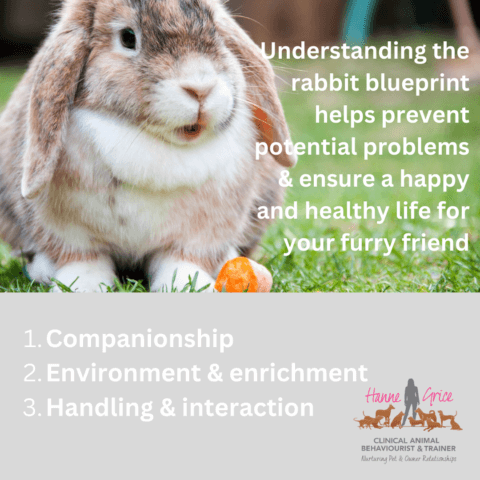Rabbits can make wonderful companions and to ensure the best possible care and wellbeing for these adorable animals, it is crucial for owners to understand the rabbit blueprint. The rabbit blueprint encompasses inherent traits and behaviours that greatly influence their behaviour, needs, and overall quality of life. By gaining insights into the rabbit blueprint, bunny owners can prevent potential problems and provide an environment that caters to their pet’s specific needs.
The Rabbit Blueprint and Behaviour
Rabbits are natural prey animals, and their behaviour is shaped by this instinctual heritage. Understanding their blueprint is key to comprehending their behaviour and ensuring their emotional and physical wellbeing. Some fundamental traits include:
- Prey Animal Instincts: Rabbits possess a strong fight-or-flight response due to their prey status in the animal kingdom. They have a keen sense of hearing, excellent peripheral vision, and are easily startled by sudden movements or loud noises.
- Social Nature: Despite their prey instincts, rabbits are highly social animals that thrive on companionship. In the wild, they live in groups or colonies, and companionship plays a crucial role in their mental and emotional wellbeing.
- Territoriality: Rabbits are territorial animals, and they establish and defend their own spaces. They have a strong preference for routine and may exhibit territorial behaviours such as marking with scent glands and digging to establish their territory.

Avoiding Potential Problems
Understanding the rabbit blueprint is essential to prevent potential problems and ensure a happy and healthy life for your furry friend. Here are some key areas to consider:

- Environment and Enrichment: Providing a suitable living environment is crucial for a rabbit’s wellbeing. This includes a safe and spacious enclosure, away from drafts and harsh weather, that allows for hopping, running, standing upright on their back legs, flipping/turning, jumping, and digging. Enrichment activities such as toys, tunnels, stable resting platforms, and plenty of hiding spots are vital to prevent boredom and encourage natural behaviours.
- Companionship: Rabbits are social animals and benefit greatly from having a rabbit companion. Solitary rabbits can become lonely, stressed, or even depressed. When introducing rabbits, proper bonding techniques should be followed under supervision to facilitate a harmonious relationship. Many animal organisations including but not limited to Woodgreen Pets Charity, RSPCA and Blue Cross can help owners with bunny matching with their rescue rabbits, where an owner may have recently lost one of a pair and are looking to provide companionship for their remaining rabbit. The bunny’s behaviour, personality type and learning experiences will all be taken into account when looking for the perfect match, and the charities can provide guidance and support on how to introduce the rabbits slowly, with gradual positive exposures to one another, in order to promote a new harmonious rabbit relationship. Where another bunny companion is not possible, rabbits can also form great relationships with other species. For example, my lop eared rabbit Audrey grew up with my Basset Hound Howard and cat George – all three would hang out on the sofa together, potter around the garden and curl up asleep next to each other, having created their own unique family.
- Handling and Interaction: Rabbits are sensitive to how they are handled and require gentle, respectful interaction. Improper handling or mishandling can cause stress and even physical harm. Learning proper handling techniques and allowing rabbits to dictate their level of comfort is essential. Avoid towering over your rabbit, instead stay low to the ground and allow your rabbit to approach. Never flip your rabbit upside down so they are on their back as this can cause extreme terror and this method, known as Tonic Immobility or less formally as ‘trancing’, is often seen in videos displayed on social media platforms, because the rabbit appears to be hypnotised. While trancing may appear intriguing or amusing to some, it is essential to understand that this behaviour is not a sign of relaxation or contentment. In fact, trancing in rabbits is considered harmful and stressful for several reasons including
- Stress and Fear: Trancing induces a state of extreme stress and fear in rabbits. When rabbits are placed in an unnatural position, their instinctual response is to freeze and become immobilised, which can trigger a fear response. This can lead to a significant increase in stress hormones and emotional distress for the rabbit.
- Vulnerability: In the wild, a rabbit lying on its back is in a highly vulnerable position. This is contrary to their natural instincts and can be interpreted as a sign of danger or threat. When rabbits experience this position during trancing, it can cause them to feel a loss of control and a heightened sense of vulnerability, leading to heightened stress levels.
- Physical Discomfort and Health Risks: Trancing can also result in physical discomfort for rabbits. When a rabbit is immobilised in a position that restricts their natural movement, it can lead to muscle strain, decreased blood circulation, and potential injury. Prolonged trancing can have detrimental effects on their physical health and overall wellbeing.
- Negative Association: Repeated exposure to trancing can cause rabbits to associate certain handling or situations with stress and fear. This can lead to a breakdown in trust between the rabbit and their caregiver, making it more challenging to handle them safely and causing unnecessary anxiety in the future.

Individual Differences
While the rabbit blueprint provides a general understanding of their behaviour, it is important to recognise that individual differences exist. Factors such as genetics, early socialisation, and past experiences can influence a rabbit’s temperament and behaviour. Some rabbits may be more outgoing and friendly, while others may be shy or skittish. It is crucial to observe and understand your rabbit’s unique personality to cater to their specific needs. And, any interactions with rabbits should focus on building trust, providing positive reinforcement, and engaging in activities that promote their physical and mental stimulation.
Key take-aways
By delving into the rabbit blueprint, owners can gain a deeper understanding of their rabbits’ needs and behaviour. This knowledge empowers owners to create an environment that minimises potential problems and maximises their rabbits’ wellbeing. It is crucial to consider each rabbit as an individual and tailor their care accordingly. By fostering companionship, providing appropriate enrichment, and handling rabbits with care, owners can ensure a fulfilling and happy life for their beloved companions.
Consulting with your veterinarian or an experienced registered and certified rabbit behaviourist can provide further guidance on proper rabbit handling techniques and ways to ensure their wellbeing. To find appropiate behavioural support, check out the Animal Behaviour and Training Council’s website.
Learn more about our classes

Get Hanne's book, clothing and more
Hanne has a number of publications including her book Playing With Your Dog to help owners work out the games that are best suited for their pet to play throughout his life, from puppyhood to old age, available from Amazon. Check out Hanne's range of contemporary casuals The Collection – for pet lovers made from recyclable, organic materials that are sustainably sourced.

